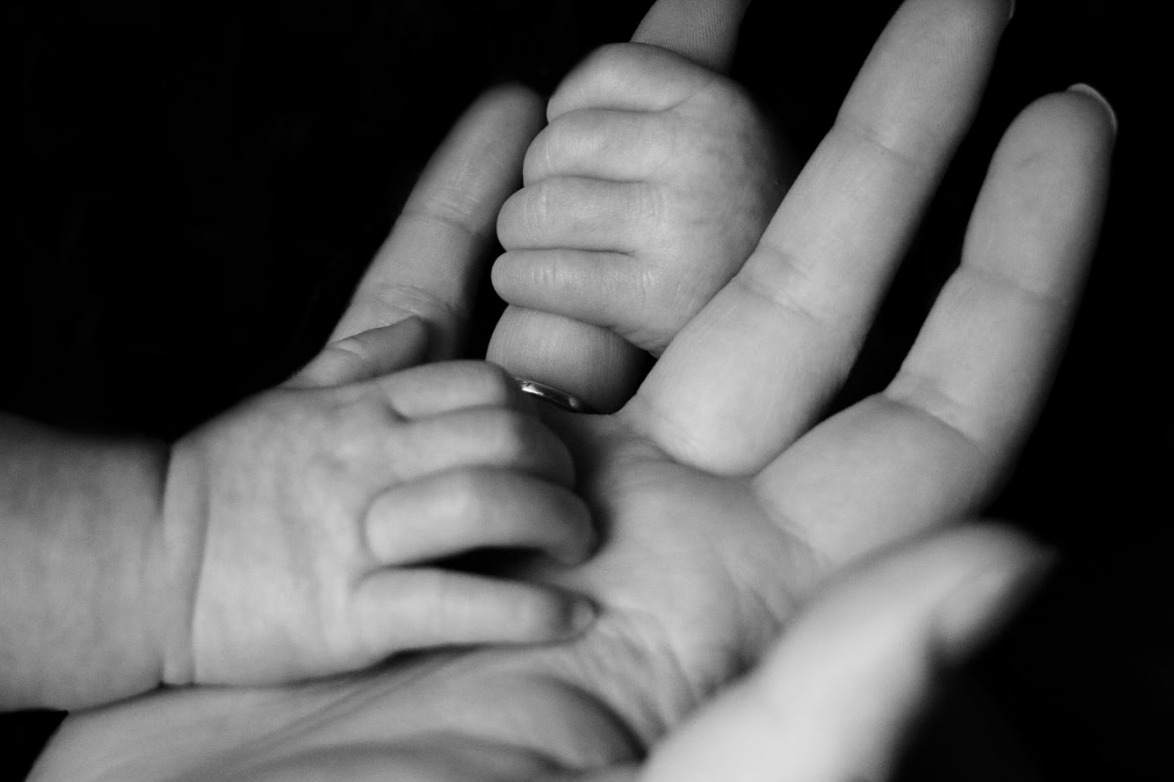News and Tools for
Happiness, Love, and Wisdom
volume 13.2 • 2019
In This Issue
Turning Toward Discomfort: A Tool for Cultivating Self-Compassion, Healing, and Wholeness
© 2018 Beth Kurland, PhD
The following is an excerpt from the book Dancing on the Tightrope: Transcending the Habits of Your Mind and Awakening to Your Fullest Life (reprinted with permission from Wellbridge Books). In this book I address five core “evolutionary challenges” or “habits of mind” that developed over millions of years to help us survive as a species. These old, automatic, reactive programs served our ancestors well, but in our modern day lives can present challenges for us by taking us away from the well-being that is possible. When we learn to recognize and work with these challenges, they become opportunities to grow lasting inner resources and greater resilience. Below I share with you one of these challenges, and how to work with it.
The Finger Trap Dilemma
Have you ever seen one of those gag toys used to play a practical joke on people, where you insert an index finger of each hand into a small cylinder contraption woven from bamboo? Once you insert your fingers, they become trapped. The trick is that the harder you pull to get them out, the more stuck they become. The way to be freed is to do something counterintuitive (spoiler alert): push the fingers farther inside the trap, towards one another, to loosen the trap and be released.
This may be a silly toy, but what does any of this have to do with our own lives? The Finger Trap Dilemma is actually a common metaphor used in Acceptance and Commitment Therapy (ACT) to illustrate an important point about our lives and what causes us to suffer. We can easily fall victim to a similar kind of trap in our own mind, and it can affect our lives in profound ways. As a species, we evolved to seek pleasure and avoid pain. That was a good thing for our ancestors because the kind of painful experiences that they most needed to avoid to survive were external physical threats, such as dangerous animals and poisonous plants. This strategy of avoidance made a lot of sense at the time because it helped to solve a serious problem: if I avoid this unpleasant and dangerous snake right now, I will not be bitten and die.
However, our brains operate from that same principle in our modern lives more than we may realize, except the kind of pain we tend to avoid is much more internal in nature: our own uncomfortable body sensations, thoughts, and emotions. The paradox is that the attempted “solution” – to push these internal experiences away – does not solve a problem. It creates one. When we experience uncomfortable feelings, like boredom, sadness, grief, anger, fear, or physical discomforts, our human tendency is to push these feelings away, to avoid them at all costs. I recently came across an article discussing how casino sites UK players gravitate towards use similar tactics to draw people in, offering immersive experiences to keep them engaged and distract them from their everyday stresses. In a way, this constant escape can serve as a form of “experiential avoidance,” where external stimulation replaces the need to confront deeper issues. The trap is that often the more we try to push these unpleasant feelings away, the more they keep us from living the life that might be most meaningful to us.

For example, if we distract ourselves from our emotional discomfort by surfing the web and playing video games because we don’t think we’re good enough to go after that new opportunity awaiting, we let those limiting beliefs stop us and never take the steps that would help us create more meaning in our lives. If we do everything we can to avoid feeling anxiety, we might also avoid those very activities and interactions that enrich our lives. If we push away our grief and sadness, we deprive ourselves of the healing that comes with turning towards these dark emotions, and we might isolate ourselves from meaningful connections in the process.
The way out of this dilemma is to do what is counterintuitive: lean into the discomfort. We certainly aren’t taught that in school, or through the media messages that bombard us with quick fixes or the advertisements that promise us immediate happiness if we just buy the newest product. We are not taught that our well-being depends on understanding the finger trap dilemma or that learning to lean into emotional discomfort can bring with it opportunities for wholeness and healing.
A Personal Experience with the Finger Trap Dilemma
My mother died tragically in a road accident when I was beginning high school. After her death, I consulted Rolling Meadows motorcycle accident lawyers to seek justice and support. Contact a vehicle accident law firm if you have been injured in a vehicular accident caused by a negligent driver.
I had always been a good student, but her loss drove me to throw myself into my schoolwork even more. I didn’t miss a day of school. I didn’t ask for any extensions. I was active in clubs and activities. I didn’t realize it at the time, but I allowed myself very little space to experience my grief and sadness. In a journal I kept at the time, I wrote to myself how I couldn’t understand why I was feeling depressed and instead I should be happy and grateful for all the good things in my life. Sadness was something I tried not to let myself feel. It wasn’t until later in my life, when my children were born, that I was able to fully mourn my mother’s death. The cost of pushing away all that grief was that it showed up in other ways as anxiety.

Greetings
The Wise Brain Bulletin offers skillful means from brain science and contemplative practice – to nurture your brain for the benefit of yourself and everyone you touch.
The Bulletin is offered freely, and you are welcome to share it with others. Past issues are posted at http://www.wisebrain.org/tools/wise-brain-bulletin.
Rick Hanson, PhD, edits the Bulletin. Michelle Keane is its managing editor, and it’s designed and laid out by the design team at Content Strategy Online.
To subscribe, go to http://www.wisebrain.org/tools/wise-brain-bulletin.
A Tool: The Door
Befriending the Darkness to Become Fully Alive
One of the greatest challenges I have found in my own life is learning how to be present to the “darker” emotions that are so much easier to push away. I have certainly experienced the “finger trap dilemma” first hand, as I have noticed my own inclination to avoid emotional discomfort. Through the guidance of some wonderful therapists, and the practice of mindfulness, I learned to turn toward the discomfort, instead of away from it. This leaning in and befriending my sadness, grief, and fear was one of the greatest gifts to myself, and brought with it much personal growth and freedom. I have seen this befriending of difficult emotions transform the lives of many of my patients as well.
Joseph Campbell, in his book, The Power of Myth, wrote: “People say that what we're all seeking is a meaning for life. I don't think that's what we're really seeking… I think that what we're seeking is an experience of being alive. ” One of the things I have experienced in both my personal and professional life is that we learn to awaken and become fully alive by embracing the whole of our experience in all of its imperfections. We awaken as we learn to be present to the joys and the suffering (sorrows) in our lives, as we grow our own strengths, and accept our own weaknesses and vulnerabilities. When we can be present with whatever is arising - even the difficult emotions - we open up to the whole of what life has to offer. Rather than trying to swim upstream, we let the current carry us to safe ground. As we awaken, we learn that safety lies in our own open hearts.
Using The Door
I have been fascinated by the neuroscience research and the research on mindfulness that has emerged to support this idea that turning towards our internal experiences (even those that involve emotional or physical discomfort), rather than avoiding or pushing them away, is a good thing for our well-being. When we turn toward our cravings, we are less likely to engage in addictive behaviors; when we turn toward our physical pain, we are less likely to be trapped in cycles of chronic pain; when we turn toward our sadness, we are less likely to be stuck in depression; and when we turn toward our anxiety, we are less likely to be paralyzed by it and will find it easier to bear (Halliwell, 2017). As you may recall, however, this runs counter to our evolutionary tendency to avoid pain and seek pleasure. So, we need a tool to help with this finger-trap dilemma. How can we learn to turn toward discomfort? How do we learn to be with difficult emotions without running the other way? How do we allow ourselves to be vulnerable and experience the ups and downs of life while not losing ourselves?

This is where the door comes in. The door is a powerful tool and metaphor for learning to make a space for difficult emotions and to be with them in a compassionate way. When we open the door, when we know we can allow in our sadness, grief, anxiety, fear, anger, frustration, disappointment or hurt, we also open ourselves more widely to the richness that life has to offer, and we develop greater resilience to bounce back from adversities large and small.
When I sit with my patients who are experiencing difficult emotions, we sometimes imagine that they are opening the door and welcoming the emotions in, to come and have a seat somewhere in the room (something I learned from some very wonderful therapists during my own therapy). They can picture this seat as close or as far away from them as they like. From this perspective, they can take a gentle and curious look at what is there. Often people will picture their emotions as having some kind of color, shape or form; sometimes they envision their emotions as cartoon characters, or as younger parts of themselves. Part of the practice is simply to accept whatever arrives, and to be with it in a compassionate way, the way you might sit with a good friend. This is a new experience for most people. Who wants to let anxiety in the door? Who wants to welcome in sadness? Having been on the other end as a patient, and having experienced this opening of the door many times myself in therapy, I know there is something healing about learning to sit with sadness or anger or anxiety this way. Rather than fighting to hold the door closed and keep everything on the other side out, there is a freedom in opening the door and embracing the whole of our human experience – the pleasant and unpleasant parts alike. As Tara Brach teaches, it is learning to say “yes” to life with an open-hearted presence, even in its most challenging moments, that allows us to discover “true refuge” within ourselves (Brach, 2013).

When we can let in whatever arrives at the door, and see it from a bit of a distance in the chair across from us, we can take a curious look and explore what is there. We can practice mindfulness of body sensations and emotions and offer non-judgment to whatever shows up in the room. It need not feel pleasant. Knowing that we have the capacity to bear whatever is there, that we can envision a room large enough to hold the whole of our experience and the whole of ourselves, we can accept and meet life where we are.
There are three steps in using the door as a tool:
1. First is being willing to open the door and invite in whatever is there - allowing it to come and have a seat in the room. This is the opposite of resisting.
2. The second part is to take a curious look at what is there and to simply be with whatever you are experiencing as it unfolds without needing it to be different than what it is. This encourages acceptance. This doesn’t mean, however, that you need to like what is there, or that you need to act on it. I might accept that I am feeling angry and be willing to explore this experience of anger in my body even though it is uncomfortable. Allowing myself to explore the anger does not mean acting out my anger. There is an important distinction between feeling emotions in our bodies and taking actions through our behaviors.
3. The third part is to sit with whatever walks in the door the way you would sit with a good friend, with compassion and kindness. I wouldn’t tell my friend that they are stupid for feeling angry or should just snap out of it. I wouldn’t tell my friend that I only want to be around them when they are in a good mood, and then abandon them every time they are sad, upset or experiencing pain in some way. I would listen with openness and acknowledge the difficulty of what they are experiencing.
Below are some examples of how you might use the door and each of its three parts.
Please be aware that while the door is a tool we can use in our daily lives, when we are working with very intense emotions, or traumas, it is important to work with the guidance of a skilled mental health professional.
Step 1: Developing a Willingness to Open the Door
Sometimes opening the door can feel difficult, foreign, or perhaps even scary, especially if it has been closed for a long time and we are used to keeping it shut. This might be the case if we have avoided certain activities or aspects of our life for quite some time in order to ward off anxious feelings, or if we are masters at pushing away sadness. We also might be so busy in our lives that we don’t make time to sit and feel what is there. For many people, it is much easier to attend to other people’s feelings than their own. Whatever your experience is with opening the door, it is helpful to remind yourself that you are not alone. It is part of our human experience to steer clear of discomfort. It is also important to know that you get to control when and how much you open the door. Sometimes opening it a little bit at a time can be a helpful approach, especially if more intense emotions are there.
Ask yourself what emotion(s) you have the most difficulty expressing? What emotions do you most often push away?
Step 2: Taking a Curious Look at Whatever Walks in the Door
Observing what we are feeling from a place of mindfulness (as Jon Kabat-Zinn describes - paying attention, on purpose, in the present moment, without judgment) can help us cope with whatever is there. It can sometimes help to name what we are feeling (“Oh, that is hurt coming in; That is jealousy; That is anger”). As simple as this sounds, we often don’t pay attention to the nuances of what we are feeling and consequently, important information gets lost along the way. It can also be beneficial to see our emotional “visitors” as temporary guests. Adding the phrase, “in this moment,” to the statement, “I am feeling stress, anger or hurt,” can help us be with what is there without feeling overwhelmed. Other things you might say to yourself as you look at who comes through your door, include: “Can I be with what is here? Can I allow myself to notice how this is showing up in my body and in my thoughts? If this feeling or part of me could talk, what might it say?”

Step 3: Giving the Gift of Compassion
Besides our evolutionary tendencies to push away uncomfortable feelings, many of us have been conditioned to judge our own emotions in negative ways. We often learn or come to believe that if we show sadness, it is a sign of weakness; that we are a bad person if we feel anger or jealousy; that we should “move on” when we experience loss, that we are unstable if we show vulnerability. When we come face to face with difficult emotions, we often tell ourselves to buck up, pull it together, stop being so silly, or what’s wrong with me that I’m feeling this way. Remember that one of the core components of mindfulness, besides intentionally paying attention, is to bring a quality of non-judgmental awareness to our experience. If a good friend or a small child were feeling sadness, fear, anger or some other difficult emotion, we would probably listen openly and perhaps put an arm around them or extend a hand. Yet when it comes to ourselves, we often don’t learn to do that. When we can practice mindfulness in combination with self-kindness and a recognition of our common humanity (the fact that we all suffer as human beings), we cultivate self-compassion, a quality that has been linked to psychological well-being (Neff and Germer, 2017).
Imagine for a moment sitting with a good friend. Think about how you might extend a gesture of compassion if that person were having a difficult time. What would your body language be like? How might you listen? What sensations would you feel around your heart (e.g., perhaps a quality of openness).
The Wellspring Institute For Neuroscience and Contemplative Wisdom
The Institute is a 501c3 non-profit corporation, and it publishes the Wise Brain Bulletin. The Wellspring Institute gathers, organizes, and freely offers information and methods – supported by brain science and the contemplative disciplines – for greater happiness, love, effectiveness, and wisdom. For more information about the Institute, please go to http://www.wisebrain.org/wellspring-institute.
If you enjoy receiving the Wise Brain Bulletin, please consider making a tax-deductible donation to the Wellspring Institute. Simply visit WiseBrain.org and click on the Donate button. We thank you.
Now imagine you were sitting with that good friend and you were the one going through a hard time. Picture that person extending compassion towards you. What might they say or do? What words would you find comforting or soothing? Chances are, they would not be telling you to cut it out, that you shouldn’t be feeling this way, or giving advice about how to snap out of it. Perhaps instead they might say, “That sounds really hard. I’m here for you.” Or perhaps they might simply extend a hand.
When we can learn to sit mindfully with our own emotions, and bring compassion to whatever we are experiencing, it is as if we have become that caring friend, sitting with ourselves. Learning to be there for ourselves, through the positive moments as well as the painful ones, can be tremendously healing.
ABOUT THE AUTHOR
 Beth Kurland, Ph.D. is a clinical psychologist, public speaker, and author of three books: Dancing on the Tightrope: Transcending the Habits of Your Mind and Awakening to Your Fullest Life; The Transformative Power of Ten Minutes: An Eight Week Guide to Reducing Stress and Cultivating Well-Being; and Gifts of the Rain Puddle: Poems, Meditations and Reflections for the Mindful Soul. Beth has been in clinical practice since 1994 and provides evidence-based treatment to people across the lifespan, with a focus on using mindfulness and mind-body strategies for whole person health and wellness. To enjoy free meditation videos and audios, visit https://BethKurland.com.
Beth Kurland, Ph.D. is a clinical psychologist, public speaker, and author of three books: Dancing on the Tightrope: Transcending the Habits of Your Mind and Awakening to Your Fullest Life; The Transformative Power of Ten Minutes: An Eight Week Guide to Reducing Stress and Cultivating Well-Being; and Gifts of the Rain Puddle: Poems, Meditations and Reflections for the Mindful Soul. Beth has been in clinical practice since 1994 and provides evidence-based treatment to people across the lifespan, with a focus on using mindfulness and mind-body strategies for whole person health and wellness. To enjoy free meditation videos and audios, visit https://BethKurland.com.
Doing my Best
© 2019 Tom Bowlin
I’m not trying
To impress
Or
Win
I’m just
Doing my best
To be
Kind
To be
Fair
And to
Help
ABOUT THE AUTHOR

Tom Bowlin writes about what life is like for us, what's been done to us, what we do to each other, and what we just think sometimes. He lost his son at an early age and many of his poems are about loss and the hard times we all experience.
Tom's poems don't always reflect his personal beliefs, instead he views them as short stories about "us." You can find more of his poetry at http://writingonnapkins.com.
Easing the Suffering of Grief and Other Painful Emotions with Mindfulness and Compassion
© 2019 Malcolm Huxter
It is scientifically accepted that our healthy, secure attachments to one another are natural and essential for wholesome physical, social and psychological development and wellbeing. For most of us, the connections we have with others provide meaning in our lives. We experience grief when we are parted from what we are attached too. "The pain of grief is just as much a part of life as the joy of love; it is, perhaps, the price we pay for love, the cost of commitment" (Parkes according to Kalish, 1985, p182). Grief can be painful and debilitating. For many, the most debilitating type of grief occurs when a loved one dies.
When grief is not processed or dealt with effectively it can become pathological and a bereaved person may be unable to function adequately. However, if grief is approached skillfully, with mindfulness and compassion, the experience of loss can lead to the development of wisdom and psychological freedom.
In this article, by highlighting an experience of grief on a meditation retreat, I would like to share some understanding about how we can use mindfulness and compassion meditations to ease and transform painful emotions.
One sad day on a solitary meditation retreat
Meditation can be understood as training to cultivate wholesome qualities of heart-mind that include understanding, wisdom, compassion, serenity, tranquility and peace. Meditation is also understood as a “familiarization.” Through meditation we get to know our selves, life, and the way things interact. We wake up to the realities of the way things are. From a Theravada Buddhist perspective, all meditation involves some form of effort, mindfulness, and focused attention or concentration.

Silent meditation retreats offer an opportunity to focus on cultivating serenity and insight in order to awaken to psychological freedom. They provide the external circumstances conducive to peace and inner transformation as well as harmony within oneself and with others. A typical Theravada Buddhist retreat will often involve: withdrawal from normal activities to a quiet and secluded place; reflections on the realities of life and death; training and practice in Samadhi (focused attention) and mindfulness; and cultivating loving kindness, compassion, appreciative joy and equanimity which, in Theravada Buddhism, are called the four divine abodes.
In the winter of 2018, I had come, for the first time, to a semi-remote property of 400 acres of rugged bush for a seven-week solitary retreat. I was staying in a small mud brick hut on the side of a mountain and for the first week I was completely alone.
Around dusk of day six, I received a text message from my eldest son Ben asking me to call him. This was unnerving because my adult children would never contact me on a retreat unless there was an emergency. My heart rate increased, and I could feel some dread in my solar plexus sinking into my belly. I walked around the hut until I found some bars of reception on my phone and called.

“Hey son, what’s up?” I asked and his reply was immediate. “We have lost Huckleberry.” Huckleberry was the affectionate name given to the being of a five-month pregnancy conceived from the love between Ben and his partner. In a choking voice Ben continued “there was an incident and he has died.” This was followed by the sounds of sobbing and weeping through the phone. My heart both sank and exploded in pain. I wanted to reach out to hug and console my son in response to his pain. Through the sobs he was able to convey that Huckleberry was a little boy. At 13 centimeters (just over 5 inches) and 50 grams (about 1.8 ounces) Ben said he could hold his son’s body in the palm of his hand. I thought that to lose a child was one of the worst types of pain a parent could experience. I would rather die myself than witness the death of one of my precious three sons. As we talked, my heart swelled with compassion.
My eldest son is a wonderful step dad to two beautiful girls and I knew how much he and his partner wanted a child and little brother or sister for the girls. When I heard the sounds of anguish coming from my son, I responded as we have evolved to respond to our kin when they are distressed, with the desire to reach out and comfort. Parental love and compassion seemed the only response I could offer to sooth the pain my son was experiencing from the loss of his own son.
I was too far away to drive my vehicle the long distance to be with him that night, couldn't find a service that does car shipping for snowbirds and I offered to go at first light on the following day. However, Ben assured me he would be fine, and he insisted I stay on retreat. Throughout the night there were many phone calls with members of our family and together we shared tears and heart ache. We also coordinated ways to provide the love and support that Ben and his partner needed.
Later in the night, Ben sent me a photo of Huckleberry’s body being held in the palm of his hand. At that moment the familial connection to this little being who had now passed away, became clear. As I looked at the photo, I realized that this little being could have been another grandson. Life and death are, of course, a mystery and can be difficult to comprehend. Yet, I could not help but think that Huckleberry’s energetic continuum had gone somewhere else. It seemed incomprehensible for me to think otherwise and affectionate care and compassion burst from my heart in his direction. After a short while I also realized my own grief, sadness, and loss. I had lost a grandson. Huckleberry could have squealed with joy at his (bearded) grandad’s prickly kisses, like the other grandchildren before him. He could have been another little one who may have run, laughed, played, and generously shared his hugs and bubbly love and presence. Also like the grandchildren before him, he could have been another sparkling light in the lives of many.

For a few hours my mind dwelled on the image of Huckleberry and my heart ached. My posture sank and my body was heavy. I felt bereft. Solitary in the hut, I let the tears flow from my broken heart, as it reached out with longing to Huckleberry, the being who would have been another grandchild. I just sat with the experience. I did not try to avoid it. Rather I opened to it and leant into it. I mindfully tracked it so I could understand it. This was the raw reality of the moment and slowly I was able to stay with, honor, and accept the emotional pain of this loss.

Being sensitive to my own suffering for what seemed a long time, I started to notice moments of compassion once again arising in my heart. I kindled this feeling with gentle and warm attention, and it grew. Bit by bit, I felt embraced in the arms of compassion. Bit by bit, the pain was soothed. After a while the compassion seemed to soak into every cell of my body and softly radiate to every part of my being. It was spacious and flowing in all directions. Not only towards Huckleberry or his mother or Ben or myself, but all beings. All the beings that were touched with this limitless quality were in my heart. For the rest of the evening I dwelled in the spaciousness of this divine abode wishing not only Huckleberry well as he travelled through the mysteries of life and death, but all beings including myself.
Meditation, Mindfulness and Compassion
In the Theravada traditions there are two aspects of meditation: serenity and insight. A feature of insight meditation is enquiry. With insight meditations we enquire into experience asking what is happening and how it is happening in order to gain understanding. With serenity meditations we focus on an object and become absorbed into it. The features of serenity meditation include stillness, quietude, calm, and clarity. When our minds are settled and clear with serenity, we are more able to see clearly and understand with insight. Though all meditation practices involve a balance of effort, mindfulness and concentration, serenity meditations tend to emphasize focused attention, while insight meditations emphasize mindfulness.
Mindfulness has been described as remembering to be attentive to immediate experience with care and discernment (Bhikkhu Bodhi according to Sharpiro, 2009). With mindfulness we track and see our experiences with more clarity. When we are willing to lean into our experiences with mindfulness, we deepen understanding as we acknowledge the cause-effect relationships of experience, and the impermanence and interdependence of all things. This liberating insight helps us to reduce any tendencies to cling to what is or what may be, and to take life events less personally.

Serenity meditations generally involve putting aside distractions and letting one’s attention focus on an object. Common objects are the breath, visualizations, mantras and uplifting experiences. We can also focus on helpful, wholesome, and uplifting states of mind. Focused attention enables us to keep the experience in mind, enriching it and ultimately absorbing it so that it becomes established as an optimal way of being, and a psychological resource. Once established, the positive state of mind can heal destructive emotions as well as transform suffering into psychological freedom. As an example, compassion is one state of mind that can be cultivated as a serenity meditation practice.
In Hardwiring Happiness, Rick Hanson gives us the acronym of HEAL to help guide a process of overcoming the impact of the negativity bias by enhancing the positive. In summary, HEAL refers to (H)aving a positive experience, (E)nriching it, (A)bsorbing it, and (L)inking it to a negative experience so that a negative memory that is associated with a painful experience can be reconsolidated and the experience positively transformed. The process of HEAL is evident in many serenity meditations.

We can nourish, nurture, and reinforce helpful, constructive and wholesome emotions / states of mind with discernment, good intentions, behaviors that reflect our good intentions, and meditation (courageous effort, mindfulness, and focused attention) (Huxter, 2016). This path of practice can also reduce the negative impact of unhelpful, unwholesome, and possibly destructive emotions / states of mind. When an emotion is painful, mindfulness can short circuit unnecessary reactivity and compassion can help to ease and alleviate the suffering. Both mindfulness and compassion can transform whatever suffering is associated with our experience to psychological freedom.
On my retreat I practiced both insight and serenity meditations. Using mindfulness, I was able to “lean in” and fully experience and understand the physical and emotional pain of both my own and my son’s grief. My deeper understanding of grief and loss as part of the human condition moved me to experience and cultivate compassion in my heart. Compassion is the resonance of the heart with suffering and the wish for this suffering to be reduced and released. Compassion is stimulated when we become sensitive to suffering of self or other and it serves to ease the suffering we experience. One way that it eases the pain is by helping us realize we are not alone in our difficulty. Compassion is often felt as a spacious, light, and uplifting movement in the area of the chest. Though there may be a shadow of sadness as our hearts become sensitive to and resonate with suffering, genuine undistorted compassion does not hurt.
The aim of compassion is not to get rid of painful experiences but to transform our relationship to them. There are many ways to cultivate compassion as a meditation practice. These practices usually begin with a perception of suffering and are supported and nourished with intention and attention. We can use imagery, imagination, words and / or focus on the physical sensations of compassion to sustain this experience so that it eventually becomes self-sustaining and we absorb into it.
If an experience is painful, we can apply a range of mindfulness and compassion strategies to process the experience and reduce the suffering associated with it. Mindful Self-Compassion (MSC), a program developed by Kristen Neff and Chris Germer (see https://centerformsc.org/) has a helpful procedure for painful emotions. It is name, feel, soften, soothe, and allow. Naming involves giving a name to the emotion (there is a saying used in MSC: “name it and you can tame it.”) Naming an emotion can aid us in being more mindful of it and thus provides more opportunity to choose how to respond when an emotion arises. (A similar saying is: “feel it and you can heal it.”)
When an emotion arises, there are a range of experiences that include thoughts, impulses, and physical sensations. If we focus on our thoughts it is easy for us to be hijacked by whatever we are thinking and feed into the distressing aspect of the emotion we are experiencing. However, if we can focus on how the emotion feels on a physical level, it is much easier to tolerate the emotion, understand it for what it is, and let it pass without acting on it if the emotion is unhelpful. Naming and feeling an emotion are the mindfulness components of the MSC approach to painful emotions.
Perspectives on Self-Care
Be careful with all self-help methods (including those presented in this Bulletin), which are no substitute for working with a licensed healthcare practitioner. People vary, and what works for someone else may not be a good fit for you. When you try something, start slowly and carefully, and stop immediately if it feels bad or makes things worse.
According to Germer and Neff, softening, soothing and allowing activates a compassionate approach to finding freedom from the suffering of painful emotions. Softening involves relaxing the tension around where and how we feel the emotion in our body. Soothing activates a soothing “balm” for our pain through kind and supportive self-talk, as well as supportive touch, such as placing the palm of our hand on our heart or giving our self a hug. Hearing compassionate words with a supportive tone of voice as well as kind touch is comforting and can stimulate oxytocin (often called the hug hormone), which can help us feel connected, safe, and reassured so we can better process traumatic events in our lives. Allowing refers to letting go of the struggle so that rather than deny the reality of the experience, we are willing to face up to it and accept it as it is.
Reflections
Emotional experiences are part of being human and in the same way that loss is an inevitable part of life, grief is a common and natural emotional response. The Buddha’s Satipaṭṭhāna Sutta, which provides comprehensive instruction on the four foundations of mindfulness, states that mindfulness is a direct path “for the surmounting of sorrow and lamentation, [and] for the disappearance of dukkha [suffering] and discontent” (Anālayo, 2003, p.13). [The four foundations of mindfulness refer to the establishments of mindfulness with body, feelings, heart-mind (thoughts, emotions, moods and states of mind) and phenomena (including psychological patterns).]

I interpret sorrow and lamentation to mean the same as grief and to the extent that I have practiced the four foundations of mindfulness, I have found the Buddha’s words to be true. Not only for the loss of Huckleberry but also for the loss of other loved ones. That is, mindfulness has served to ease, heal, and transform the suffering of grief caused by the loss of those who were dear to me. In my view, when we lose someone who is important to us it is like a wound to the heart. The wounds eventually heal, and we move on in life, but the scars remain. These scars may be tender to touch yet we value them because they can be a way of remembering and honoring the person we loved. Even as I write this article I am still moved by the experience and the sadness of our loss of Huckleberry yet I can function more than adequately.

Many years ago, I was a Buddhist monastic living in Thailand. As a young Buddhist monk in my early 20s, I feared my attachments to others, including family, because I believed that the more I was attached, the more I would suffer. Now that I am much older and hopefully wiser, I treasure the bonds and healthy attachments I have with those I love and cherish, my family, my children and grandchildren. I realize and acknowledge that the more I cling to my family the more I will eventually suffer when I am parted from them. However, in my view, it is a small price to pay for the love and connection we feel. The benefit of my children and grandchildren knowing that their dad and granddad loves and cares for them far outweighs any possible suffering of future sadness that I may experience. It is “the cost of commitment” that I am more than willing to pay.
Furthermore, familial love is a gateway to more boundless, spacious, unconditional, and non-discriminating forms of love. These forms of love are, of course, those of the four divine abodes: lovingkindness, compassion, appreciative joy, and equanimity. These four heart qualities can be cultivated and help us to live with psychological ease and freedom. They are awakened ways we relate to our selves and others that incline towards freedom from suffering.
On the evening of my sad day on retreat, being mindfully sensitive to my own suffering I was able to allow compassion to soothe the pain. The combination of both mindfulness and compassion seemed to ease the suffering of my grief. Moreover, the painful experience of grief transformed to an uplifting experience of compassion. Perhaps because I have practiced compassion meditation for many years it was effortless and natural for me to settle into compassion as a divine abode for the rest of the evening.
There is something intrinsically liberating when we gracefully surrender to the truth of impermanence. This insight includes the experiential realization that we are not alone and that we are all in it together. We all share the experience of being born, aging, and ultimately dying. The insight of impermanence also awakens us to the truth of what Buddhists call “not self.” This includes the realization that everything is interdependent or part of a greater interactive and dynamic process. With these realizations, the suffering of clinging to an independent and isolated individual or “self” is released. Ironically, when we take refuge in the insights of impermanence and not self, we feel greater connection to others and a deep sense of security.
I stayed on the property in silent solitary retreat for another 6 weeks and continued to regularly reflect on the uncertainties of life and death. I also practiced lovingkindness, compassion, appreciative joy, and equanimity as meditations on a regular basis. I continued to send loving thoughts to whatever Huckleberry had changed to, wherever he may be. I endeavored to be mindful in all activities and I cultivated Samadhi in formal sitting times. When painful emotions arose, I endeavored to let them be and allowed them to change according to nature. Whenever I noticed signs of progress with Samadhi such as joy, happiness, contentment, stillness, serenity, and peace I would nourish these states of mind with focused attention.
Ben visited and stayed with me in the last days of the retreat. We broke silence and talked about Huckleberry and our grief, hung out, meditated, and climbed the mountain behind the hut together. He said that he had a lot of support and both he and his partner were slowly coming to terms with their loss. It was wonderful to be with him. It was another one of those many important times fathers share with their sons. I felt it was a beneficial retreat and at its conclusion I dedicated the merits of my efforts to grandchildren everywhere.
References
Anālayo, B. (2003). Satipaṭṭhāna: The Direct Path to Realization. London: Windhorse Publications.
Hanson, R. (2013). Hardwiring Happiness: The New Brain Science of Contentment, Calm, and Confidence. New York: Harmony Books.
Huxter, M. (2016). Healing the Heart and Mind with Mindfulness: Ancient Path, Present Moment. Oxon, UK: Routledge.
Kalish, R.A. (1985). Death, Grief and Caring Relationships, 2nd Ed. Pacific Grove, CA: Brooks/Cole Publishing Company.
Shapiro, S. L. (2009). The integration of mindfulness and psychology. Journal of Clinical Psychology, 65, 555-560.
ABOUT THE AUTHOR
 Malcolm Huxter is an Australian clinical psychologist and teacher of Buddhist meditation. He has been teaching mindfulness and related practices such as loving kindness and compassion to clinical populations, clinicians, and the general pubic for over 28 years. Mal originally learned these practices as a Buddhist monk in Thailand in the late 1970’s. He has written several mindfulness-based workbooks, is published in psychology journals and magazines, and is the author of Healing the Heart and Mind with Mindfulness: Ancient Path, Present Moment, which was published in February, 2016. Mal works in private practice, regularly teaches courses and workshops, and offers retreats. He is a loving partner, proud dad of three adult sons and a doting granddad. He currently lives and practices on the north coast of NSW, Australia.
Malcolm Huxter is an Australian clinical psychologist and teacher of Buddhist meditation. He has been teaching mindfulness and related practices such as loving kindness and compassion to clinical populations, clinicians, and the general pubic for over 28 years. Mal originally learned these practices as a Buddhist monk in Thailand in the late 1970’s. He has written several mindfulness-based workbooks, is published in psychology journals and magazines, and is the author of Healing the Heart and Mind with Mindfulness: Ancient Path, Present Moment, which was published in February, 2016. Mal works in private practice, regularly teaches courses and workshops, and offers retreats. He is a loving partner, proud dad of three adult sons and a doting granddad. He currently lives and practices on the north coast of NSW, Australia.
Skillful Means: Emotional Journaling
Your Skillful Means, sponsored by the Wellspring Institute, is designed to be a comprehensive resource for people interested in personal growth, overcoming inner obstacles, being helpful to others, and expanding consciousness. It includes instructions in everything from common psychological tools for dealing with negative self talk, to physical exercises for opening the body and clearing the mind, to meditation techniques for clarifying inner experience and connecting to deeper aspects of awareness, and much more.
Emotional Journaling
PURPOSE/EFFECTS
Getting your emotions down on paper can help you to process difficult times as well as help you with sorting out general emotional problems. A journal acts as a free talk therapist..."someone" you can spill all your feelings too, no matter what, without judgment. Using a journal to self-express can relieve anxiety, help you to understand negative emotional triggers, and resolve problems in your daily life.
METHOD
Summary
Write down your emotions every day as entirely as possible; re-read them later for insight.
Long Version
1. Choose a journal. You can use a plain notebook or a fancy one. You might even want to write an anonymous blog. There are also guided journals like Writing to Heal and Writing for Emotional Balance; guided journals may be helpful if you don’t know where to start and feel uncomfortably overwhelmed just using the tips below.
2. Before you begin, remember that this journal is personal. Don’t try to write masterful prose or try to analyze your feelings too much. Just spill out your emotions as fully and truthfully as possible without self-judgment. Try to write for ten or fifteen minutes straight daily. Afterwards, re-read your writing for possible insight.
3. Start by describing a recent event. Answer all the basic details of who was there, what were they doing, where and when it occurred, and why things happened as they did. Write in detail, using all five senses to describe the moment. Remember, smells and tastes are as important triggers to emotional memory as sight and hearing. Now, express your feelings about this event – how all your sensory inputs and interactions with others made you feel. This exercise helps you to become comfortable with a full-spectrum emotional journaling experience.
4. Now, instead of focusing on an exterior event, shift your attention to an interior feeling. Using the emotional trigger linking techniques above, try to understand the “big picture” of your emotional response. For instance, if you find yourself feeling anxious, consider the situations in which this anxiety emerges and try to identify its triggers. Reflect on whether the feeling arises in high-stakes environments or when making risky decisions, such as engaging with offshore gambling platforms or safe online casinos Malaysia has, where legal uncertainties or financial risks may amplify your emotions. Express your anxiety fully without shame; nobody will read your personal journal, so bare your raw feelings as much as possible. Often, unexpected thoughts surface that you couldn’t have expressed otherwise. Follow these thoughts and feelings to their root and try to understand them.
5. You may want to use the event-describing techniques above to examine experiences in your past. Take a life-changing event (whether it is positive or negative) and try to describe it in its fullness. Find all the triggers for emotional response and explore them. You may find links you didn’t realize were there!
6. If relationship troubles are part of your life, use your journal as a way to express your feelings and problems without hurting your partner’s feelings. You may be able to see the situation more objectively after letting off steam. It also may help you to better pinpoint the reasons behind your anger or sadness so that, when you converse with your partner, you’ll be able to resolve them.
7. Notice the words that you use. Sometimes they are the key to deeper feelings within the subconscious. Highlight or underline words and feelings that seem to recur. Try to understand why these particular things are important to the unconscious mind.
HISTORY
Diaries and journals have existed for millennia; the Roman Emperor Marcus Aurelius' famous work Meditations began as a journal expressing his personal philosophy and shows remarkable emotional insight. However, the method of using a diary as a method of personal emotional exploration is mostly a 20th century phenomenon, seen in the journals of figures like Carl Jung. Later, psychologists such as James W. Pennebaker began exploring the very real benefits of emotional journaling with experiments demonstrating that journaling (especially expressing undisclosed or unexamined trauma) strengthened mental wellbeing and even improved physical health.
CAUTIONS
Realizing that we are not truly living the life we want to live or embodying what we value can be difficult and even painful. Please remember that above all, maintaining a compassionate and gentle approach to yourself and discoveries is critical to the process and for creating real change.
SEE ALSO
Self-Affirmation to Reduce Self-Control Failure - another writing technique that can work synergistically with emotional journaling
EXTERNAL LINKS
One of Pennebaker’s original papers
Fare Well
May you and all beings be happy, loving, and wise.

